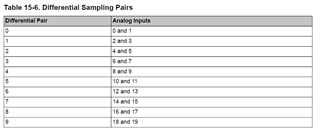Hi,
I want to read 3 analog voltage signals in an experiment. I want to implement this with the EK-TM4C1294XL part without any additional hardware. From what I have read in the datasheet, it seems so, because it consists of 2 ADC modules to which 20 analog inputs can be connected. I understand that the reading of the 3 then could be done on a single ADC, sequentially. In case you can really do that, what is the maximum sampling frequency at which I can read the 3 signals ?
Thanks in advance for your help
Regards
Adrian Llanos




